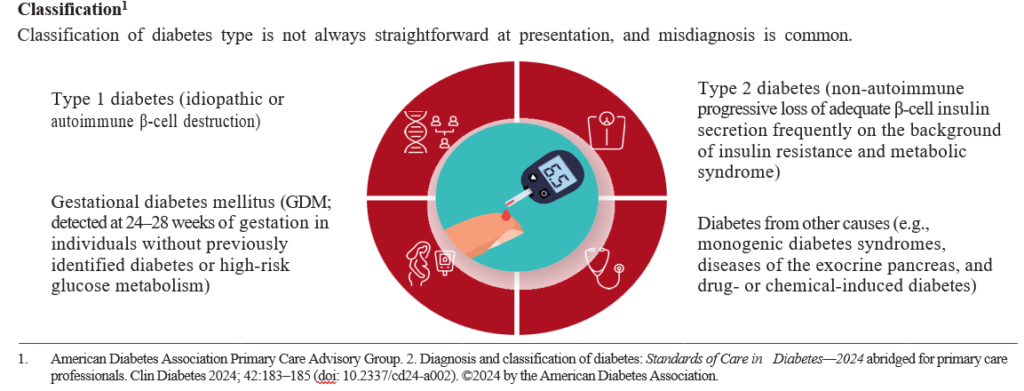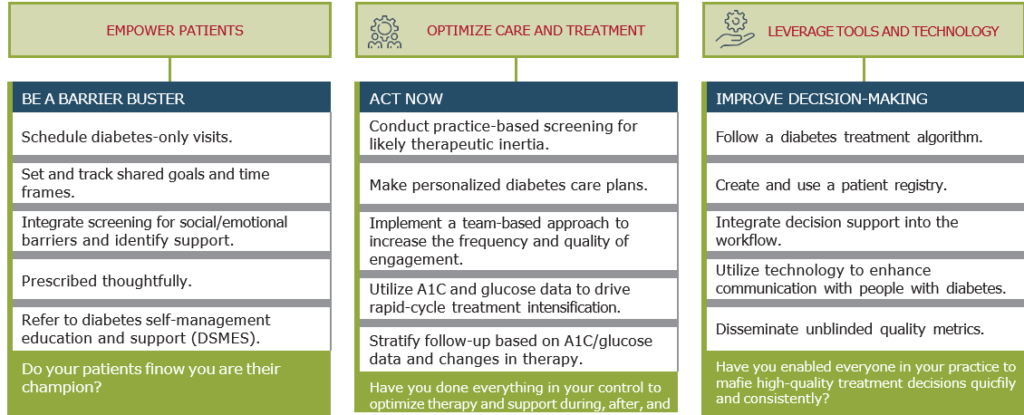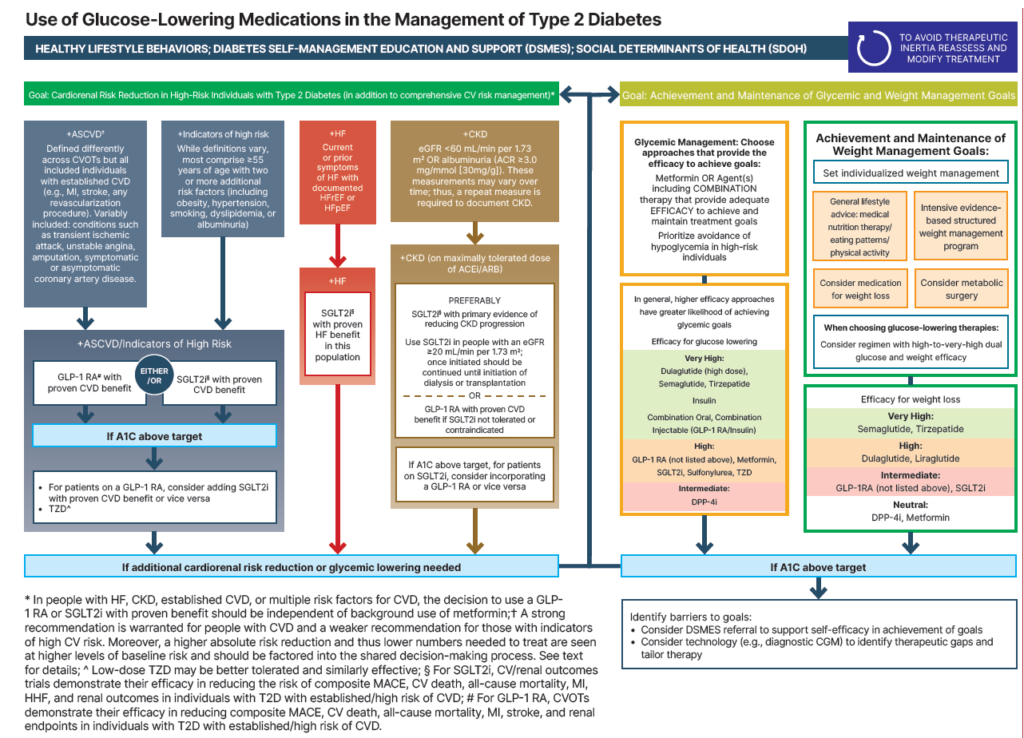Diagnosis and Management
Rajesh Jain1*, V Seshah2
2Distinguished Professor, The Tamil Nadu Dr. M.G.R. Medical University, Chennai, Tamil Nadu; 2Jain Hospital & Research Centre, Kanpur, India
Submitted: 20 June 2024; Accepted: 10 July 2024; Published: 15 July 2024
Corresponding Author: 1*Dr Rajesh Jain, 108 B Gandhi Gram, Jain Hospital & Research Centre, Kanpur-208007, India, Email: [email protected]
Diagnostic Tests for Diabetes
Diagnostic criteria

Random glucose value with classic hyperglycemia symptoms/ hyperglycemic crisis
- Insufficient evidence supports continuous glucose monitoring for screening or diagnosing prediabetes or diabetes.
- In the absence of unequivocal hyperglycemia (e.g., hyperglycemic crisis), diagnosis of type 2 diabetes requires confirmatory testing, which can be a different test on the same day or the same test on a different day.
- Marked discordance between A1C and repeated blood glucose measurements should raise the possibility of a problem or interference with either test.1

What medications can be prescribed to adults to prevent type 2 diabetes?
The U.S. Food and Drug Administration has not approved any drugs for diabetes prevention. Metformin has the strongest evidence base for diabetes prevention.


Staging of type 1 diabetes2,3
| Stage 1 | Stage 2 | Stage 3 | |
| Characteristics | AutoimmunityNormoglycemiaPresymptomatic | AutoimmunityDysglycemiaPresymptomatic | AutoimmunityOvert hyperglycemiaSymptomatic |
| Diagnostic criteria | Autoantibodies may become absentDiabetes by standard criteria. | Islet autoantibodies (usually multiple)Dysglycemia: IFG and/or IGTFPG 100–125 mg/dl (5.6–6.9 mmol/L)2-h PG 140–199 mg/dl (7.8–11.0 mmol/L)A1C 5.7–6.4% (39–47 mmol/mol) or ≥10% increase in A1C | Autoantibodies may become absentDiabetes by standard criteria |
- Adapted from Skyler JS, Bakris GL, Bonifacio E, et al. Differentiation of diabetes by pathophysiology, natural history, and prognosis. Diabetes 2017; 66:241–255.FPG, fasting plasma glucose; IFG, impaired fasting glucose; IGT, impaired glucose tolerance; 2-h PG, 2-h plasma glucose. Alternative additional stage 2 diagnostic criteria of 30-, 60-, or 90-min plasma glucose on oral glucose tolerance test ≥200 mg/dL (≥11.1 mmol/L) and confirmatory testing in those aged ≥ 18 years have been used in clinical trials. Herold KC, Bundy BN, Long SA, et al.; 3.Type 1 Diabetes Trial Net Study Group. An anti-CD3 antibody, teplizumab, in relatives at risk for type 1 diabetes. N Engl JMed 2019; 381:603–613.
қ Does statin therapy increase the risk of developing type 2 diabetes?
- Statin therapy may slightly elevate type 2 diabetes risk in high-risk individuals.
- In primary and secondary prevention of cardiovascular disease, statin benefits outweigh diabetes risk.
- Discontinuing statins based on concerns about increased diabetes risk is not advised.
қ Does pioglitazone have a role in secondary cardiovascular prevention in people at risk for type 2 diabetes?
Pioglitazone could reduce stroke and myocardial infarction risks in people with a history of stroke and evidence of insulin resistance or prediabetes. However, the benefit must be weighed against potential weight gain, edema, and increased fracture risk. Lower doses may lessen these adverse effects.
Pharmacologic Approaches to Glycemic Treatment
Ways to Address or Prevent Therapeutic Inertia for People with Type 1 or Type 2 Diabetes


Reference
1. American Diabetes Association Primary Care Advisory Group. 2. Diagnosis and classification of diabetes: Standards of Care in Diabetes—2024 abridged for primary care professionals. Clin Diabetes 2024; 42:183–185 (doi: 10.2337/cd24-a002). ©2024 by the American Diabetes Association.
2. Skyler JS, Bakris GL, Bonifacio E, et al. Differentiation of diabetes by pathophysiology, natural history, and prognosis. Diabetes 2017; 66:241–255
3. Type 1 Diabetes Trial Net Study Group. Teplizumab is an anti-CD3 antibody used in relatives at risk for type 1 diabetes. N Engl JMed 2019; 381:603–613.
4. American Diabetes Association Primary Care Advisory Group. Pharmacologic approaches to glycemic treatment: Standards of Care in Diabetes—2024 abridged for primary care professionals. Clin Diabetes 2024; 42:206–208 (doi: 10.2337/cd24-a009). ©2024 by the American Diabetes Association.
- Acknowledgment: We would like to express our deepest gratitude to Americal Diabetes Association 2024 Guidelines For Primary Care Physician
- Funding
Not applicable
- Informed Consent
Not applicable
- Conflict of Interest Statement
All the authors declared “No Conflict of Interest” with this publication.
- Additional Information
Not applicable
This open-access article is distributed under the terms of the Creative Commons Attribution License CC-BY 4.0., which permits unrestricted use, distribution, and reproduction in any medium, provided the original author and source are credited.
- DOI: 10.62996/daj.10072024
Cite this article: Rajesh Jain1*, Veeraswamy Seshiah2.Clinical Diabetes in Primary Care 2024. Diabetes Asia Journal. 2024; 1(1):76-80


